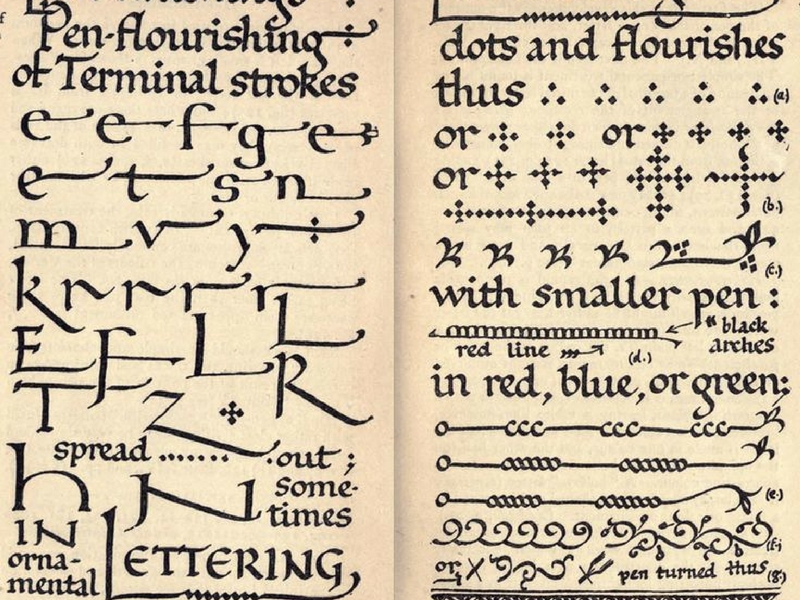 Oct
11
Oct
11
Modern calligraphy
- October 11, 2017
- 0 Comment(s)
Revival
After printing became ubiquitous from the 15th century, the production of illuminated manuscripts began to decline. However, the rise of printing did not mean the end of calligraphy.
The modern revival of calligraphy began at the end of the 19th century, influenced by the aesthetics and philosophy of William Morris and the Arts and Crafts movement.Edward Johnston is regarded as being the father of modern calligraphy. After studying published copies of manuscripts by architect William Harrison Cowlishaw, he was introduced to William Lethaby in 1898, principal of the Central School of Arts and Crafts, who advised him to study manuscripts at the British Museum.
Join us for a calligraphy workshop
This triggered Johnston’s interest in the art of calligraphy with the use of a broad-edged pen. He began a teaching course in calligraphy at the Central School in Southampton Row, London from September 1899, where he influenced the typeface designer and sculptor Eric Gill.He was commissioned by Frank Pick to design a new typeface for London Underground, still used today (with minor modifications).
He has been credited with reviving the art of modern penmanship and lettering single-handedly through his books and teachings – his handbook on the subject, Writing & Illuminating, & Lettering (1906) was particularly influential on a generation of British typographers and calligraphers, including Graily Hewitt, Stanley Morison, Eric Gill, Alfred Fairbank and Anna Simons.Johnston also devised the simply crafted round calligraphic handwriting style, written with a broad pen, known today as the Foundational hand. Johnston initially taught his students an uncial hand using a flat pen angle, but later taught his hand using a slanted pen angle. He first referred to this hand as “Foundational Hand” in his 1909 publication, Manuscript & Inscription Letters for Schools and Classes and for the Use of Craftsmen.

Graily Hewitt taught at the Central School of Arts and Crafts and published together with Johnston throughout the early part of the century. Hewitt was central to the revival of gilding in calligraphy, and his prolific output on type design also appeared between 1915 and 1943. He is attributed to the revival of gilding with gesso and gold leaf on vellum. Hewitt helped to found the Society of Scribes & Illuminators (SSI) in 1921, probably the world’s foremost calligraphy society.
Subsequent developments
An example of Graily Hewitt’s calligraphy.Hewitt is not without both critics and supporters in his rendering of Cennino Cennini’s medieval gesso recipes.Donald Jackson, a British calligrapher, has sourced his gesso recipes from earlier centuries a number of which are not present in English translation.Graily Hewitt created the patent announcing the award to Prince Philip of the title of Duke of Edinburgh on November 19, 1947, the day before his marriage to Queen Elizabeth.
Johnston’s pupil, Anna Simons, was instrumental in sparking off interest in calligraphy in Germany with her German translation of Writing and Illuminating, and Lettering in 1910.Austrian Rudolf Larisch, a teacher of lettering at the Vienna School of Art, published six lettering books that greatly influenced German-speaking calligraphers
Because German-speaking countries had not abandoned the Gothic hand in printing, Gothic also had a powerful effect on their styles.
Related Blog: https://www.dsignz.in/calligraphy-workshop-in-mumbai
Rudolf Koch was a friend and younger contemporary of Larisch. Koch’s books, type designs, and teaching made him one of the most influential calligraphers of the 20th century in northern Europe and later in the U.S. Larisch and Koch taught and inspired many European calligraphers, notably Karlgeorg Hoefer, and Hermann Zapf.
Contemporary typefaces used by computers, from word processors like Microsoft Word or Apple Pages to professional designers’ software like Adobe InDesign, owe a considerable debt to the past and to a small number of professional typeface designers today.Unicode provides “Script” and “Fraktur” Latin alphabets that can be used for calligraphy. See Mathematical Alphanumeric Symbols.
Source: Wikipedia
